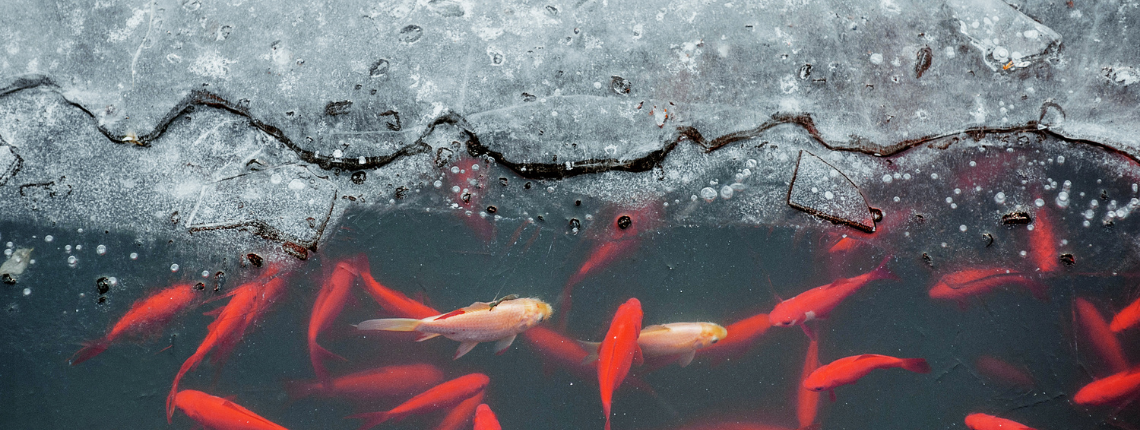December 01, 2021
What Causes Fish Kill in the Winter?
Why subsurface pond aeration helps keep fish alive in the winter

Fish kill is a common occurrence in many northern states during the harsh, cold winters. As the temperature falls, ice can form across the entire pond and stay for months. This sets off a chain of events that can deplete oxygen levels and ultimately suffocate fish. Let’s dive into the science behind the reduction in dissolved oxygen levels and how an aerator can keep your fish alive and healthy.
Aquatic plant oxygen production decreases
Aerator for Fish Kill Prevention
Submerged plants and microscopic algae (phytoplankton) are nature’s primary source for oxygen in a pond. With full ice coverage, sunlight is far less likely to reach aquatic plants and often can’t produce as much oxygen.
Normally plants supply the ecosystem more oxygen than they consume. With lack of sunlight, plants consume more oxygen than they produce, leaving less for fish and other organisms.
Oxygen does not exchange at the water surface
Nature’s other primary source for infusing oxygen into a pond is the atmosphere. With full ice coverage, water has no contact with the atmosphere and can’t absorb oxygen as it normally would.
Toxic gasses replace dissolved oxygen
During autumn when the leaves fall and organisms start to die off, ponds accumulate organic matter at the bottom. Beneficial aerobic bacteria eat away at the “muck”, and as a bi-product, harmful gasses such as methane, hydrogen sulfide, and C02 are released into the water column and eventually into the atmosphere. If a pond is iced over, the toxic gasses are trapped and start to eliminate dissolved oxygen.
Subsurface aeration: a quick and easy solution
Subsurface aeration – or bottom diffused aeration – is an energy efficient, quiet, and highly effective process of increasing dissolved oxygen levels and circulating water throughout the pond.
Creates an opening in the ice
One of the advantages of subsurface aeration in any season is that it mixes the pond from the bottom up – evenly distributing oxygen and helping the pond turn over.
As the pond turns over, water reaches the surface and absorbs oxygen. In the winter, water circulation helps create a hole in the ice. This allows for the deadly gases to escape, for sunlight to reach aquatic plants, and for water to reach the surface and receive oxygen from the atmosphere.
Adds dissolved oxygen
The tiny bubbles that are diffused with subsurface aeration infuse oxygen into the water column from the bottom up. This not only provides dissolved oxygen for fish, but it feeds aerobic (beneficial) bacteria, which can continue to consume the organic matter throughout winter. This should make for less cleanup and a clearer pond in the spring.
Set-up Tips
It’s important to move the diffuser away from the deepest part of the pond. If you have a six-foot deep pond, move the diffuser closer to the shore to a depth of about three feet.
The warmest water in the pond is at the bottom and is where fish reside in the winter. If the diffuser is placed at the deepest part of the pond, it will circulate the warm water and evenly distribute the cold water – disrupting the natural habitat.
Moving the diffuser closer to the surface also makes it easier to create a hole in the ice and makes the pond safer for humans or animals. They can more easily get out of the pond if they were to fall in through the hole in the ice.
If possible, it’s best to keep your aerator in a warm building or under some type of shelter. Pumping warm air into the pond will actually increase positive results.
Year-long aeration is recommended for best results. If you need help selecting the right size pump, check out our pumps sizing article.
Author: Mike Miner
More Pond Aeration Content
- What Size Air Pump Should I Buy?
- DIY Pond Aeration
- How to Calculate Backpressure
- What Type of Diffuser
- How Water Depth, Pipe Size and Diffuser Type Affect Longevity
- DIY Solar Pond
- For all HIBLOW pond aeration content click here
A HIBLOW Aerator for your Fish
We’ve manufactured air pumps for the pond and aquatic industries for over 30 years. We know that reliability, energy efficiency, and low sound levels are all extremely important for your aquatic systems. Whether you’re aerating fish transport vehicles, operating a commercial fish farm, or just keeping your backyard pond in a healthy condition—you can depend on our HP and XP series pumps for your application.
Contact us today to find the best pump for your application!